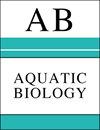Intersex in male invasive Atlantic lionfish, Pterois spp.
IF 0.8
4区 生物学
Q3 MARINE & FRESHWATER BIOLOGY
引用次数: 1
Abstract
Intersex in gonochoristic species is a reproductive abnormality in which an individual produces gametes of the type normally associated with the opposite sex. To investigate the prevalence of intersex in male lionfish Pterois spp., 884 individuals were collected from the Bahamas and North Carolina between 2004 and 2008. Histological sections of testes were scored for the presence or absence of oocytes. In intersex individuals, the number of oocytes, size, and developmental stage was recorded. The prevalence of intersex was approximately 15% and, along with all other measured metrics describing the condition, did not significantly differ between the 2 locations. Most of the intersex males displayed only primary-stage oocytes embedded in structurally normal gonadal tissue. However, 3 fish from the Bahamas exhibited oocytes of all developmental stages and complete restructuring of the gonadal tissue that is atypical of both male and female lionfish. This study is the first extensive report of intersex in lionfish, and the first in a gonochoristic reef fish.入侵大西洋狮子鱼的雌雄间性研究。
雌雄同体物种中的双性是一种生殖异常,其中一个个体产生通常与异性相关的配子类型。为了调查雄性狮子鱼Pterois spp.双性恋的流行程度,2004年至2008年在巴哈马群岛和北卡罗来纳州收集了884条个体。对睾丸的组织学切片进行卵母细胞有无评分。在双性个体中,记录卵母细胞的数量、大小和发育阶段。双性人的患病率约为15%,并且与描述病情的所有其他测量指标一起,在两个地区之间没有显着差异。大多数雌雄间性雄性只显示在结构正常的性腺组织中嵌入的初级阶段卵母细胞。然而,来自巴哈马群岛的3条鱼表现出所有发育阶段的卵母细胞和性腺组织的完全重组,这在雄性和雌性狮子鱼中都是不典型的。这项研究是第一次在狮子鱼中广泛报道雌雄间性,也是第一次在性腺礁鱼中报道雌雄间性。
本文章由计算机程序翻译,如有差异,请以英文原文为准。
求助全文
约1分钟内获得全文
求助全文
来源期刊

Aquatic Biology
生物-海洋与淡水生物学
CiteScore
2.70
自引率
0.00%
发文量
7
审稿时长
3 months
期刊介绍:
AB publishes rigorously refereed and carefully selected Feature Articles, Research Articles, Reviews and Notes, as well as Comments/Reply Comments (for details see MEPS 228:1), Theme Sections, Opinion Pieces (previously called ''As I See It'') (for details consult the Guidelines for Authors) concerned with the biology, physiology, biochemistry and genetics (including the ’omics‘) of all aquatic organisms under laboratory and field conditions, and at all levels of organisation and investigation. Areas covered include:
-Biological aspects of biota: Evolution and speciation; life histories; biodiversity, biogeography and phylogeography; population genetics; biological connectedness between marine and freshwater biota; paleobiology of aquatic environments; invasive species.
-Biochemical and physiological aspects of aquatic life; synthesis and conversion of organic matter (mechanisms of auto- and heterotrophy, digestion, respiration, nutrition); thermo-, ion, osmo- and volume-regulation; stress and stress resistance; metabolism and energy budgets; non-genetic and genetic adaptation.
-Species interactions: Environment–organism and organism–organism interrelationships; predation: defenses (physical and chemical); symbioses.
-Molecular biology of aquatic life.
-Behavior: Orientation in space and time; migrations; feeding and reproductive behavior; agonistic behavior.
-Toxicology and water-quality effects on organisms; anthropogenic impacts on aquatic biota (e.g. pollution, fisheries); stream regulation and restoration.
-Theoretical biology: mathematical modelling of biological processes and species interactions.
-Methodology and equipment employed in aquatic biological research; underwater exploration and experimentation.
-Exploitation of aquatic biota: Fisheries; cultivation of aquatic organisms: use, management, protection and conservation of living aquatic resources.
-Reproduction and development in marine, brackish and freshwater organisms
 求助内容:
求助内容: 应助结果提醒方式:
应助结果提醒方式:


